1. Ganden Monastery
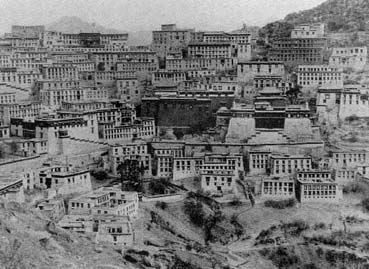
In 1409, Tsongkhapa instituted the Great Prayer Festival (sMon-lam chen-mo) at the Lhasa Jokang Temple (Lha-sa Jo-khang, Jokhang). Afterwards, his disciples, concerned about the effect of constant travel on their teacher’s health, offered to build him a monastery at any site of his choice.
Tsongkhapa accepted and chose Drogri Mountain (‘Brog ri-bo-che), approximately 50 kilometers east of Lhasa. He personally consecrated the land and named the monastery Ganden, or Tushita in Sanskrit, after the pure land realm of the future Buddha, Maitreya.
2. Drepung Monastery
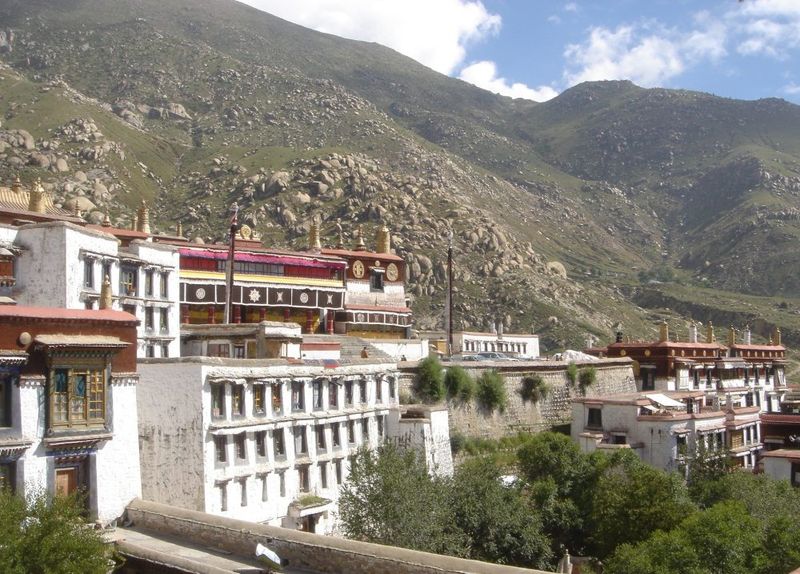
The great monastery of Drepung (‘Bras-spungs dGon-pa) was founded by Jamyang Chojey Tashi-pelden (‘Jam-dbyangs chos-rje bKra-shis dpal-ldan), a direct disciple of Jey Tsongkhapa (rJe Tsong-kha-pa Blo-bzang grags-pa), the founder of the Gelug Tradition.
This great master had presented his disciple with a white conch shell, an auspicious token that he had unearthed as a hidden treasure from a hill behind Ganden Monastery (dGa’-ldan dGon-pa). At that time, Tsongkhapa had prophesied,
You shall establish a magnificent monastery and this offspring monastery shall become more extensive than its mother one.
Neupon Namka-zangpo (sNe’u-dpon Nam-mkha’ bzang-po), the political leader of Central Tibet at that time, was requested to be the patron for the monastery. Thus, it was founded according to the Theravadin system of reckoning in the year 1960 after the Parinirvana of Buddha, or according to the Christian system in 1416 A. D. At that time, Jamyang Chojey was thirty-eight years of age.
3. Sera Monastery
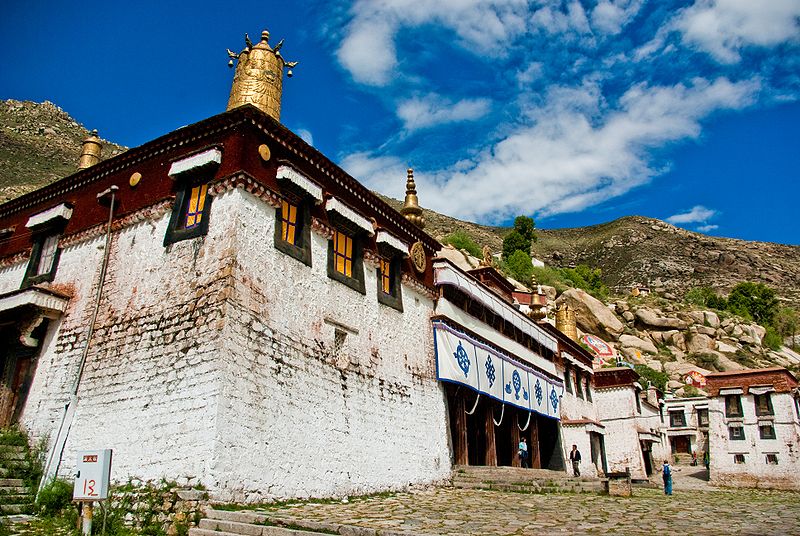
Jamchen Choje, a disciple of Tsongkhapa, founded Sera Monastery in 1419.
4. Gyuto and Gyume
In 1419, after Tsongkhapa taught his Four Combined Commentaries to the Guhyasamaja Tantra (gSang-‘dus ‘brel-ba bzhi-sbrags) at Sera Choding (Se-ra Chos-sdings) retreat, he asked who among his disciples would take care of his tantric teachings.
Gyu Sherab-Senggey (rGyud Shes-rab seng-ge) (1383-1445) volunteered, and Tsongkhapa entrusted to him his copy of the text he had just taught, the mask of Chogyel, and the skull-club he had unearthed. He also entrusted him with his skull-cup inner offering bowl, a statue of Guhyasamaja (gSang-ba ‘dus-pa), and seven special thangka (thang-ka) scroll paintings. Later that year, Tsongkhapa passed away.
In 1433, Gyu Sherab-Senggey returned to Lower Central Tibet (U, dBus) and founded Gyumay (rGyud-smad Grva-tshang) or Maygyu Monastery (sMad-rgyud Grva-tshang), the Tantric College of Lower Central Tibet, in the southern part of Lhasa, at Nordzin-Gyeltsen (Nor-‘dzin rgyal-mtshan).
At the time of the Seventh Dalai Lama, Kelzang-Gyatso (rGyal-ba bdun-pa sKal-bzang rgya-mtsho, rGyal-dbang sKal-bzang) (1708-1757), Gyumay moved to Changlochen (lCang-lo-can) in the northern part of Lhasa. In the seventh century, King Songtsen-Gampo (Srong-btsan sgam-po) had prophesied there would be a great tantric monastery at this site in the future.
In 1474, Gyuchen Kunga-Dondrub (rGyud-chen Kun-dga’ don-grub) (1419-1486), a disciple of Gyu Sherab-Senggey, left Gyumay when he was not chosen to succeed as abbot. Subsequently, he established Uto Jampel-ling Monastery (Jampel-ling Monastery of Upper U, dBus-stod ‘Jam-dpal gling Grva-tshang), better known as Gyuto (rGyud-stod Grva-tshang), the Tantric College of Upper (U).
This, and not Saygyu, is the monastery usually referred to nowadays as the Upper Tantric College. A few years after its founding, Gyuto moved to Ramoche Temple (Ra-mo-che) in Lhasa, the site of the Buddha statue brought to Tibet by the Nepalese queen of King Songtsen Gampo.
5. Namgyal Monastery
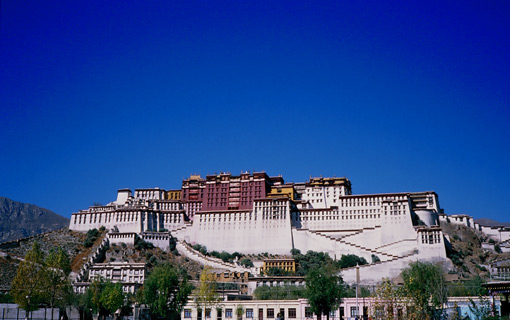
Namgyal Monastery was founded by the Third Dalai Lama, Sonam Gyatso, in 1575 and is located next to the Potala Palace.
6. Labrang Monastery (Amdo Tashi Kyil)
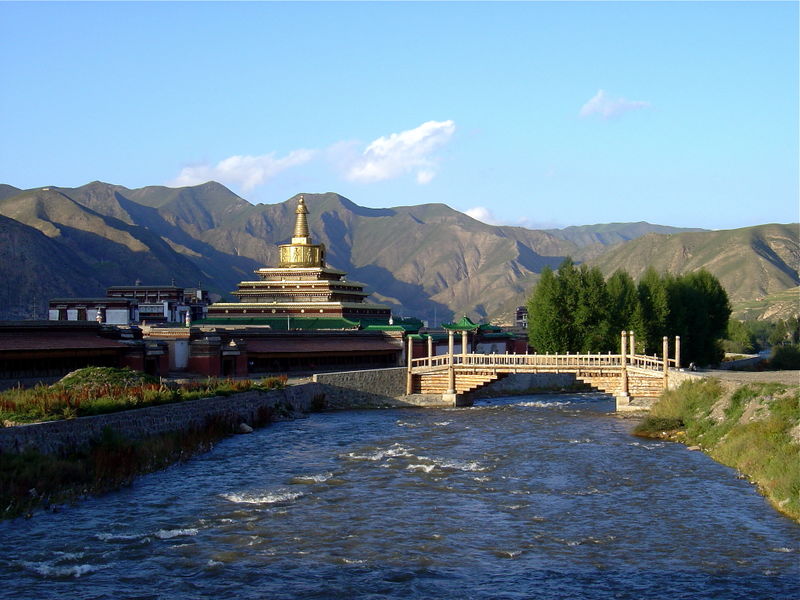
Genden Shaydrub-Dargyey Tashi-Kunnay Kyilway-Ling (dGe-ldan bshad-grub dar-rgyas bkra-shis kun-nas‘khyil-ba’i gling), also known as Labrang Tashikyil Monastery (Bla-brang bKra-shis ‘khyil), or simply Labrang, was founded in 1710 by the First Jamyang-Zhaypa, Ngawang-tsondru Kunmkhyen (‘Jam-dbyangs bzhad-pa Ngag-dbang brtson-‘grus) (1648-1722), in the Amdo province (A-mdo) of northeastern Tibet.
It lies 250 kilometers southwest of Lanchow, and is presently included in southwestern Kansu (Gansu) Province of China, near the border of Chinghai (Qinghai) Province. It is counted among the six major monasteries of the Gelug Tradition.
The First Jamyang-Zhaypa, also known as Kunkyen Jamyang-Zhaypay-Dorjey (Kun-mkhyen ‘Jam-dbyangs bzhad-pa’i rdo-rje), a disciple of the Fifth Dalai Lama, Ngawang-lozang-Gyatso (rGyal-dbang lnga-pa chen-po Ngag-dbang blo-bzang rgya-mtsho) (1617-1682), was from Amdo and had studied sutra at Gomang College (sGo-mang Grva-tshang) of Drepung Monastery (‘Bras-spungs dGon-pa) and tantra at Gyumay Lower Tantric College (rGyud-smad Grva-tshang). He authored the Kunkyen textbooks (Kun-mkhyen yig-cha) later used at Gomang, Drepung Deyang College (‘Bras-spungs bDe-dbyangs Grva-tshang), and Labrang.
When he was Abbot of Gomang, Jamyang-Zhaypa was requested by Ganden Erdene Junang, the Mongol King of Kokonor (mTsho-sngon), to return to Amdo where many Mongols lived among the Tibetans. Jamyang-Zhaypa accepted, and on the eve of his departure, the Gadong (dGa’-gdong) State Oracle prophesied that he would found a monastery in Amdo called Tashikyil. In establishing this monastery, Jamyang-Zhaypa adopted the Drepung rules of discipline and chanting style for the main temple, and the Gomang style of debate.
Jamyang-Zhaypa himself gave the name Genden-Shaydrub Tashi-Kunnay-Kyilway-Ling to his new monastery. The Second Panchen Lama, Losang-Yeshey (Pan-chen Blo-bzang ye-shes) (1663-1737), gave it a second name, Ganden Damcho-shaydrub-dargyey-ling (dGa’-ldan dam-chos bshad-grub dar-rgyas gling). “Labrang” means the residence of a great Lama. The monastery in general became known as Labrang, or Labrang Tashikyil, after the residence of Jamyang-Zhaypa. The line of his reincarnations, the Jamyang-Zhaypa Rinpoches, have been the traditional heads of the Labrang Monastery.
There has always been a strong connection between Labrang Tashikyil and the Mongols. Many lineages from Labrang, such as that of Kalachakra (Dus-‘khor), spread to the Mongolian monasteries. The Buryat, Kalmyk, and Tuvinian regions of Russia used exclusively the Kunkyen textbooks of Jamyang-Zhaypa. Many monasteries in Inner and Outer Mongolia used them as well. In Lhasa, the Mongols mostly studied at Gomang and Gyumay, as did Jamyang-zhaypa.
Labrang has six colleges. The largest is Mayjung Tosamling (sMad-byung Thos-bsam-gling), for the study of sutra and debate, established by the First Jamyang-Zhaypa in 1710 when he founded the monastery in general. It awards the Geshey Dorampa (dGe-bshes rDo-ram-pa) degree.
When the First Jamyang-Zhaypa received the Say lineage (Srad-brgyud) transmission at Saygyu Tantric College (Sras-rgyud grva-tshang) from Saygyu Konchog-Yarpel (Srad-rgyud dKon-mchog yar-‘phel) (1602-1682), this great master asked him to establish a tantric college as part of the monastery he would found in Amdo in the future. Keeping this request in mind, the First Jamyang-Zhaypa established Maygyu Dratsang (sMad-rgyud Grva-tshang), Lower Tantric College, in 1719.
The Dukor Dratsang (Dus-‘khor Grva-tshang) or Kalachakra College, Ewam-Chokor-Ling (E-wam chos-‘khor gling), was founded in 1763 by the Second Jamyang-Zhaypa, Konchog-Jigmey-Wangpo (dKon-mchog ‘jigs-med dbang-po) (1728-1798), on the advice of the Third Panchen Lama, Pelden-Yeshey (Pan-chen dPal-ldan ye-shes) (1738-1780).
The Panchen Lama’s home monastery, Tashilhunpo (bKra-shis lhun-po), built a Kalachakra temple (Dus-‘khor lha-khang) two years later, in 1765, devoted to the daily practice of the Kalachakra rituals. Since the first half of the eighteenth century, Kalachakra Colleges had already existed in Inner Mongolia. The first was at Ari-in Monastery, founded by the First Kanjurwa Gegen, Lozang-Choden (bKa’-‘gyur-ba Blo-bzang chos-ldan), and the second at Badghar Monastery (Pad-dkar dGon-pa) by his disciple, Dunkhor Pandita (Dus-‘khor Pandi-ta). The Dukor Datsang at Labrang was the first of its kind in Amdo.
The Menpa Dratsang (sMan-pa Grva-tshang) or Medical College, Sorig-Zhenpen-Ling (gSo-rig gzhan-phen gling), was established in 1784, also by the Second Jamyang-Zhaypa. The Kyedor Dratsang (Kyai-rdor Grva-tshang) or Hevajra College, Sangngag-Dargyay-Ling (gSang-sngags dar-rgyas gling), was started by the Fourth Jamyang-Zhaypa, Kelzang-Tubten-Wangchug (sKal-bzang thub-bstan dbang-phyug), in 1879. The Gyuto Dratsang (rGyud-bstod Grva-tshang) or Upper Tantric College, Sangchen-Dorjey-Ling (gSang-chen rdo-rje gling), was established in 1943 by the Fifth Jamyang-Zhaypa, Lozang-Jamyang-yeshey-tenpay-gyeltsen (Blo-bzang ‘jam-dbyangs ye-shes bstan-pa’i rgyal-mtshan).
The two Tantric Colleges at Labrang, like their models in Lhasa, studied mostly the Guhyasamaja (gSang-‘dus), Chakrasamvara (bDe-mchog), and Vajrabhairava (rDo-rje ‘Jigs-byed) tantric systems. They awarded Geshe Karamapa (dGe-bshes bKa’-ram-pa) and Geshe Ngagrampa (dGe-bshes sNgags-ram-pa) degrees, as at the two Lhasa Tantric Colleges.
The Kalachakra College was responsible for not only the Kalachakra rituals, but also those of Samvid (Kun-rig) and Vairochana Abhisambodhi (rNam-snang mngon-byang). The monks of the Kalachakra College also studied astronomy, astrology, and mathematics.
In addition to medical studies, the monks of the Medical College were responsible for the rituals of the Medicine Buddha (sMan-lha), Akshobhya (Mi-‘khrugs-pa), and the Hiddenly Realized (gSang-sgrub) form of Hayagriva (rTa-mgrin). The Hevajra College maintained the rituals for Hevajra and Vajrapani Mahachakra (Phyag-rdor ‘Khor-can), and prepared a calendar/almanac each year according to the Chinese-style black calculation system (nag-rtsis).
As at the Jokang (Jo-khang) in Lhasa, every year from the 3rd to the 17th of the first Tibetan month, Labrang held a Great Prayer Festival (sMon-lam chen-mo) with examinations for the highest grades of Geshe. At this festival, there were ritual masked dances and other rites as in Lhasa.
At its height in 1957, Labrang had nearly 4,000 monks. About 3,000 of them were at the Mayjung Tosamling College, with the rest evenly distributed among the other five colleges. Approximately three-quarters of the monks were Tibetans. The rest were mostly Outer Mongolian Mongols (phyi-sog), Inner Mongolian Mongols (smad-sog, nang-sog), Kokonor Mongols (stod-sog), Mongours (hor-pa) from northern Amdo, Yellow Yugurs (yu-gur) from Gansu (Kansu), Xinjiang Kalmyk Mongols, and ethnic Chinese. Labrang had 138 branch monasteries.
Starting in 1958, the monastery was closed for twelve years by the Chinese. During the 1970s, it was opened for tourism. It was reopened as a functioning monastery by the Seventh Panchen Lama, Chokyi-Gyeltsen-Trinley-Lhundrub (Pan-chen Chos-kyi rgyal-mtshan ‘phrin-las lhun-grub) (1938-1989), in 1980. At present there are about 500 monks, divided among the six colleges in the same proportions as before. The study program is only a fraction of what it previously had been.
7. Tashi Lhunpo Monastery
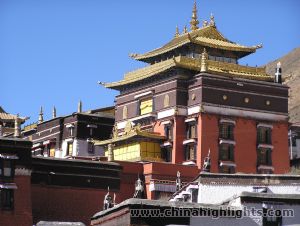
In 1447 the Monastery was founded by His Holiness the 1st Dalai Lama, Gyalwa Gendun Drup.
Source: http://www.berzinarchives.com/web/x/nav/n.html_661956143.html









































 English
English Indonesia
Indonesia Tibetan
Tibetan
Sarah
January 28, 2011
These monasteries are magnificent and in their heyday, must have housed thousands of monks. I hope they can be restored to their former glory.